Introduction
Ask any SaaS founder what keeps them up at night, and you’ll probably hear the same thing: “We’re generating leads—but they’re not closing.”
- The sales team is chasing demos that go nowhere
- Deals stall halfway through the pipeline
- The marketing team’s filling the funnel, but they’re not attracting the right accounts
You keep investing in ads, cold outreach, and content… but the revenue is nowhere to be seen. It’s not just frustrating; it’s expensive. According to Forrester, less than 1% of leads ever turn into paying customers. That means 99% of your time, energy, and budget might be getting wasted on accounts that were never fit in the first place. This is when you need to stop wasting time and start Account-based marketing (ABM).

ABM focuses your time and budget on the accounts that are most likely to buy and move them faster through the funnel. It’s targeted, personal, and measurable, everything a SaaS business needs to grow revenue without burning through resources.In this guide, I’ll break down exactly what ABM is, why more SaaS founders are betting on it, and how you can use it to close bigger deals, faster—so that you can focus your time on high-value accounts, shorten your sales cycles, and drive predictable revenue growth.
What is Account-Based Marketing?
Account-Based Marketing (ABM) is a B2B growth strategy that focuses sales and marketing resources on a clearly defined set of target accounts. Instead of generating large volumes of leads, ABM treats each high-value account as a market of one. The goal is to create personalized campaigns and experiences that engage key decision-makers, accelerate the sales cycle, and increase deal size.
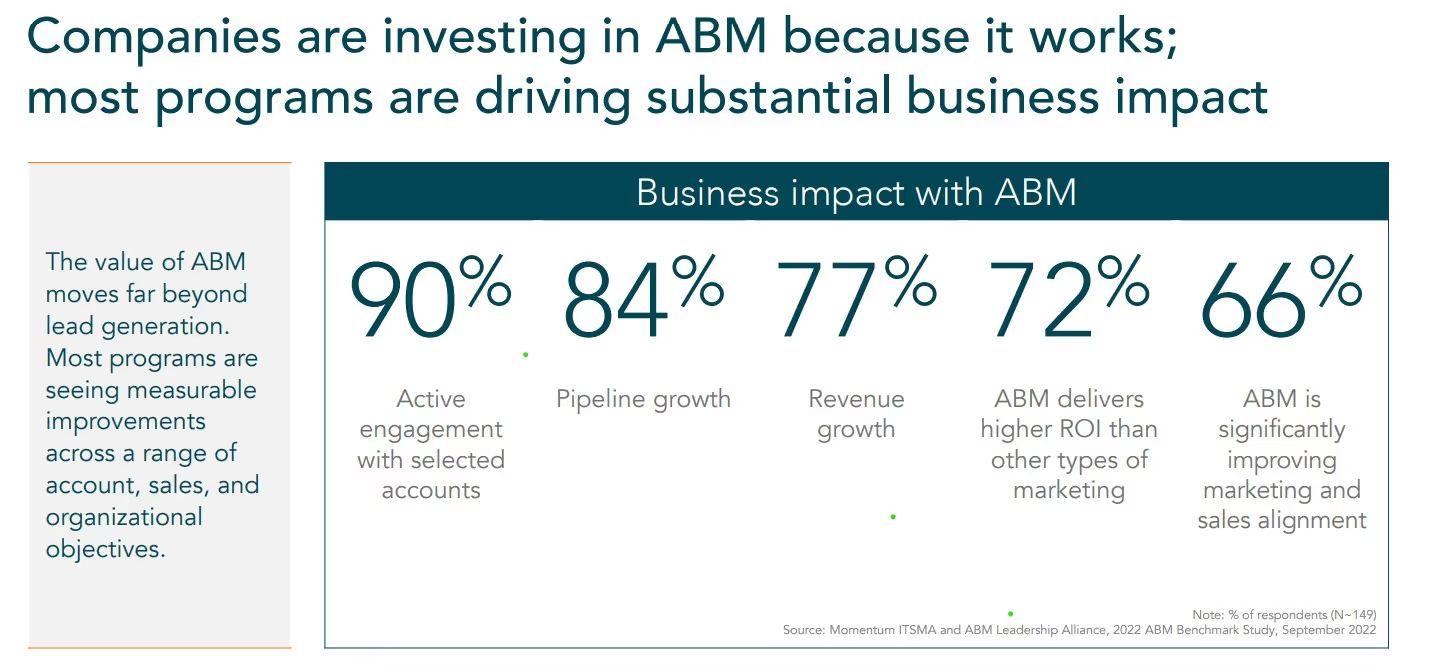
In simple terms, ABM treats each account like its own market. Sales and marketing teams work together to build tailored outreach for decision-makers inside those companies. The goal is to start conversations, speed up sales cycles, and close bigger deals.As Laura Ramos, VP and Principal Analyst for B2B Marketing Professionals at Forrester Research, puts it, “Account-based marketing takes the idea of one-to-one marketing and scales it in a sustainable way.”Unlike traditional lead generation, where you cast a wide net and hope the right leads come in, ABM ensures your time and budget are spent on accounts that fit your ideal customer profile (ICP).
How is Account-based Marketing Different from Traditional B2B Marketing?
I get this question a lot, especially from SaaS founders who are already doing B2B marketing and wondering if ABM is really that different.
The Old Way: Traditional B2B Marketing
Most traditional B2B marketing is built around lead generation. You build campaigns designed to attract as many leads as possible—through content, ads, SEO, events, etc.—and hope that the right companies show up in your funnel.
- Goal: Generate volume.
- Focus: Individual leads (MQLs, SQLs).
- Typical Tactics: Webinars, gated content, broad email campaigns, lead nurturing.
The challenge here is that only a small percentage of those leads are a real fit. So you end up wasting time and resources chasing accounts that were never likely to close. Read: Top ABM Challenges & How to Tackle Them in 2025
The Account-based Marketing Way: Focused and Account-Centric
ABM flips this model on its head. Instead of focusing on more leads, you focus on fewer, better-fit accounts from day one. Sales and marketing teams align on a list of high-priority accounts and then build personalized campaigns designed to move those accounts through the funnel.
- Goal: Win and expand key accounts.
- Focus: Entire buying committees, not just leads.
- Typical Tactics: Personalised ads, 1:1 emails, custom content, executive events, direct outreach.
Even, 74% of ABM leaders agree that ABM is responsible for driving overall strategic business growth at their company.
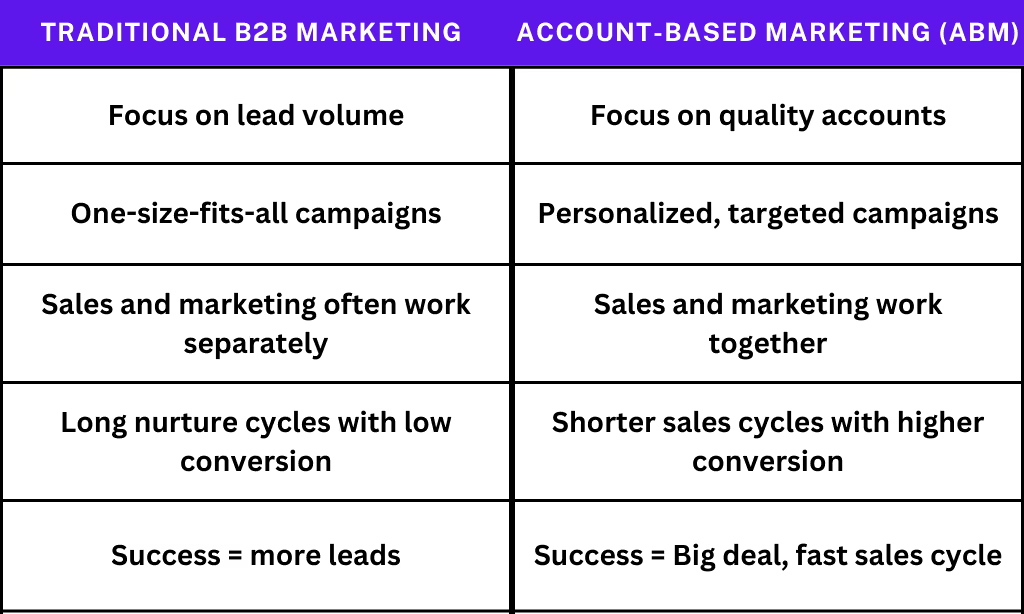
ABM is usually the smarter move if you’re selling a SaaS product with a high Average Contract Value (ACV) or targeting complex buying teams. Instead of chasing leads that never convert, you focus your time and budget on accounts that are a fit—and likely to close.
What Type of Account-based Marketing Strategy Is Right for You?
Now that you understand how ABM works, the next step is choosing the right approach. Not all ABM strategies are the same; picking the wrong one could waste your time and budget. Generally, ABM strategies fall into three categories:
- One-to-One ABM
- One-to-Few ABM
- One-to-Many ABM
One-to-One ABM
One-to-one ABM is the most personalized approach. You focus on a handful of high-value accounts and build custom campaigns tailored to each one. This strategy works best when you’re pursuing enterprise clients or accounts with the potential for large, long-term deals.Best for:
- Enterprise sales teams
- Long sales cycles
- High Average Contract Value (ACV) deals
Take Viva, for example. They’re a global industrial software company with a complex portfolio of products. One of their biggest priorities was expanding their relationship with GSK. But GSK only knew Viva for one product—their OSIsoft PI system. They had no idea Viva offered much more. Viva wanted to change that and position themselves as a strategic partner, not just another vendor.The Challenges
- Limited Awareness: GSK only saw them as a point-solution provider, not the broader partner Viva could be.
- Complex Buying Groups: It’s a massive account with lots of stakeholders across different regions. They needed to engage at the executive level to make real progress.
- Internal Buy-In: They had to shift their own teams away from product-focused marketing and towards a customer-first approach.
- A Crowded Space: GSK was hearing from loads of tech vendors. Viva needed to find a way to stand out and get noticed.
The Results
- They built a dedicated microsite, tailored to GSK’s specific needs, which drove over 2,000 visits from key people inside the account.
- They engaged 46 decision-makers and influencers at GSK, including senior execs.
- They influenced over £7 million in active pipeline within just a few months.
- They strengthened relationships at the top of GSK and boosted their reputation in the account.
This is a textbook One-to-One ABM approach. Viva picked a key account with big growth potential and built a strategy specifically for them. They delivered a personalized experience that helped reposition them as a trusted partner. That’s the power of One-to-One ABM done right.
One-to-Few ABM
One-to-Few ABM is about targeting small groups of accounts—usually grouped by industry, region, or similar challenges. You deliver campaigns that feel personalized but are scalable enough to reach more accounts than a pure One-to-One approach. Best For:
- Mid-market companies
- SaaS businesses expanding into a new industry or vertical
- Targeting 10–50 accounts at once
Let me take you back to when I was leading lead generation at KPIT Cummins. We had a tricky task on our hands. The company had just acquired a smaller firm that specialized in automotive products for large OEMs. Our job? Cross-sell and upsell business IT solutions to those OEM accounts. Simple enough on paper, but not in practice. The Challenge we faced three big hurdles:
- We needed insights. Traditional account research wasn’t cutting it.
- We had to scale personalization. There were too many accounts for a 1:1 approach but we couldn’t just batch-and-blast.
- We had to stay relevant. No generic messaging. Each account had different priorities and challenges.
The Approach: Here’s where it got interesting. Instead of sticking to the usual playbook—industry reports, directories, company websites—we turned to job portals like Naukri and Dice. It felt unconventional at first, but these portals were goldmines of information. By searching for the account name + competitor name, we found resumes of professionals who had worked with our target accounts. These CVs told us:
- What projects do they work on
- How big the teams were
- Which technologies do they use
- What their responsibilities looked like
We even took it a step further. We spoke directly to some of these professionals (many were open to a chat). They gave us insights on:
- The challenges they faced
- How decisions were made
- Which vendors they liked (and didn’t like)
But we didn’t stop there. We analyzed job postings too. That told us what tech they were investing in, what roles they were hiring for, and what projects were around the corner. If they were hiring AI and machine learning experts? We knew where their focus was shifting. Armed with all that, we built detailed account plans. We grouped accounts with similar patterns into micro-segments and tailored our campaigns around them. By applying a One-to-Few ABM approach, we turned complex, hard-to-reach OEM accounts into active opportunities. As a result, KPIT Cummins significantly improved engagement rates, shortened sales cycles, and opened new conversations that led to meaningful pipeline growth. This case proved that with the right insights and targeted execution, One-to-Few ABM can bridge the gap between high-touch personalization and scalable outreach—making it a powerful strategy for mid-market expansion.
One-to-Many ABM
One-to-many ABM is often called programmatic ABM. You’re targeting a broader list of accounts—sometimes hundreds or even thousands—using technology to personalize at scale. This approach relies heavily on data, automation, and intent signals to deliver relevant messaging to the right people. Best For:
- Companies with large Total Addressable Markets (TAM)
- SaaS businesses looking to scale pipeline generation
- Sales teams working with SDRs and BDRs to cover more ground

If there’s a company showing what’s possible with programmatic ABM, it’s Snowflake. Their team, led by Hillary Carpio, Director of ABM, runs ABM programs across 5,000 North American accounts and 9,000 globally. The Challenges
- Huge number of target accounts with different needs and buying cycles
- Needed a system to prioritize accounts and engage them at scale
- Had to coordinate efforts across marketing, sales, and SDR teams
The Results
- 46% meeting rate in their premium Snow Cat program (compared to 17% in other regions)
- 3x higher campaign attendance rates
- 2x faster deal closure times
- Increased meeting completion rate from 10% to 36% in their scaled programs
Snowflake’s approach is a good example of scaling without losing focus. They built a tiered system to manage their accounts:
- Snow Cat Premium for their top accounts (full-team engagement, partners, field marketing—all hands on deck).
- Snowball Fight for mid-tier accounts (focused on rotating 3-5 accounts per AE each quarter, based on intent signals).
- Snowmobile Foundation for scaled engagement (SDRs and ABM teams working together to engage hundreds of accounts with intent-driven outreach).
By using Bombora’s intent data and layering on first-party insights, they were able to automate outreach to thousands of accounts—while still making it feel personalized. They even created a Salesforce dashboard to pull all the data into one place, making it easy for sales teams to know who to prioritize and when. Their one-to-many ABM strategy proves you can scale personalization, engage thousands of accounts, and still get high-quality results.
How to Build and Scale an Account-based Marketing Strategy?
If you’re serious about growing your SaaS business with ABM, you need to know how to build an ABM strategy that gives results. Over the last few years, I’ve seen plenty of companies get excited about ABM—only to stall because they didn’t have a clear game plan. When Vymo approached us, they had an ambitious goal: to build a $3M quarterly pipeline by engaging 50 high-value accounts in the Indian banking and insurance sector. It was a crowded market, with traditional competitors and legacy relationships making it hard to break in. They needed a scalable ABM strategy that combined deep research, personalization, and multi-channel engagement. Here’s exactly what we did—and how you can apply these same steps.
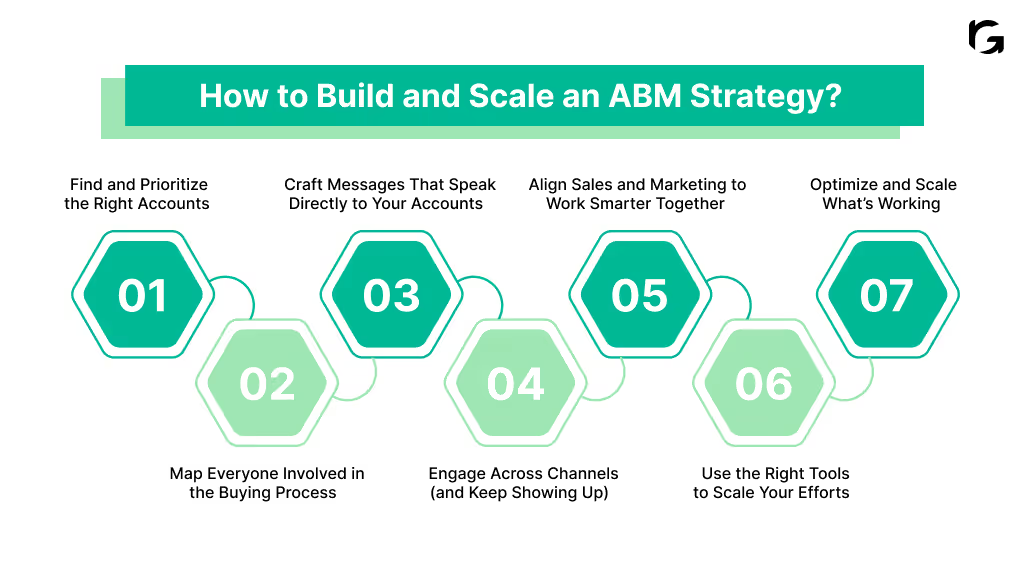
Step 1: Find and Prioritise the Right Accounts
Vymo didn’t cast a wide net. Instead, we focused on 50 high-value accounts large banks and insurance firms that were expanding their digital operations. We worked closely with their sales team to understand which accounts had the highest revenue potential and were actively investing in digital transformation. How You Can Do It
1. Define Your ICP (Ideal Customer Profile)
Think of your ICP as a blueprint for the accounts you want to win. Look at your best existing customers and find patterns. Here are some things to include in your ICP:
- Industry/Vertical: (e.g. FinTech, SaaS, Manufacturing)
- Company Size: Revenue and employee headcount
- Location: Region/countries where you can deliver value
- Tech Stack: Are they using complementary or competitive technologies?
- Business Model: B2B/B2C, Enterprise/SMB?
- Pain Points: What business problems are they trying to solve?
- Budget: Can they afford your solution?
Read this: How to find your ideal ICP.
2. Find the Right Accounts
Once you’ve got your ICP, it’s time to build your target account list. Start by mining your CRM for existing opportunities that fit the bill. Then expand your search using tools like LinkedIn Sales Navigator, ZoomInfo, or Clearbit. Step-by-Step Account Selection:
- Export a list of companies that match your ICP.
- Layer on intent data to identify accounts showing interest in your solution.
- Prioritise accounts already showing engagement on your website (using Google Analytics, HubSpot, etc.)
If you want to take it a step further, platforms like 6sense or Demandbase will show you accounts that are already researching solutions like yours (intent data).
3. Prioritize Accounts in Tiers
Not all accounts deserve the same level of effort. Divide them into tiers based on revenue potential and strategic importance.
- Tier 1 (Top 5–10 accounts): Full 1:1 personalization, executive outreach, high-touch engagement
- Tier 2 (20–30 accounts): 1: Few campaigns, industry/role-based personalization
- Tier 3 (50+ accounts): 1:Many campaigns, scalable and automated
Pro Tip: Focus on 50-100 accounts to test your ABM framework before scaling.
Step 2: Map Everyone Involved in the Buying Process
In B2B SaaS, you’re rarely selling to just one person. Gartner reports that the average B2B buying group includes 6 to 10 decision-makers. So we mapped out the key stakeholders in each account. Within those 50 accounts, we identified 250 key decision-makers (about 5 per account). These included influencers, decision-makers, and champions. Each contact was mapped to their role in the buying process. How You Can Do It
1. Identify the Buying Committee
At a minimum, identify:
- Decision Makers: Budget owners (CIO, CTO, CFO)
- Influencers: People doing the evaluation (Heads of IT, Ops)
- Champions: Advocates who will push internally
- Blockers: Legal, compliance, procurement
2. Use LinkedIn Sales Navigator to Identify Stakeholders
Once you have the roles mapped out, it’s time to find the people. LinkedIn Sales Navigator is one of the easiest tools for this. Search by company name and filter by job titles relevant to your decision-making group.
3. Understand Their Priorities
Every stakeholder has unique priorities. A CFO wants to know about ROI, while an IT leader is more concerned about integrations and data security. For each stakeholder, answer:
- What are their KPIs?
- What challenges are they trying to solve?
- What’s their role in the buying process?
Step 3: Create Messages That Speak Directly to Your Accounts
The next step is personalization—but at scale. Our research (seller interviews and mystery shopping) gave us critical insights into each account’s pain points. We personalized every email and ad message to show how Vymo could help accelerate digital onboarding and improve customer retention—key priorities in banking and insurance. How You Can Do It
1. Craft Messaging for Each Persona
Write messages that talk to each role. For instance,
- For CFO: Talk ROI, revenue impact
- For IT Director: Talk security, integration
- For Operations: Talk efficiency, productivity gains
2. Lead With Their Problems, Not Your Product
Your product isn’t the hero—they are. Start your messaging by addressing their pain points, not your features. For example: “Banks like yours are losing customer trust because of delayed onboarding processes. ”Follow that with how you solve it: “Vymo automates onboarding, cutting delays by 40%.”
3. Create Message Templates for Each Stakeholder Type
While you’ll customize each message, you don’t need to start from scratch every time. Build templates based on stakeholder types (e.g., CFO, IT Director). For each persona, draft:
- An email template
- LinkedIn outreach message
- Follow-up message
Step 4: Engage Across Channels (and Keep Showing Up)
You’ve probably heard this before, but it’s worth repeating: Account-based Marketing is not about a single email or ad campaign. It’s about orchestrated, consistent outreach across multiple channels. So for Vymo, we ran LinkedIn campaigns targeting these decision-makers with blogs, webinars, case studies, and white papers. We also did direct outreach via email, and for top-tier accounts, we sent personalized gifts and organized roundtables. This multi-channel approach helped us stay top-of-mind.How You Can Do It
1. Build an Outreach Plan for Each Channel
Each channel should have a clear role in your strategy. Some warm them up. Others push them to act.
- LinkedIn Ads → Build awareness with value-driven content (case studies, whitepapers).
- Emails → Follow up on ad engagement, offering something valuable (invitation to an event, demo, or resource).
- LinkedIn Outreach → Personal messages to key stakeholders, referencing previous touches (ads/content engagement).
- Direct Mail → For warm accounts, send a personalized gift or invite to an exclusive event.
- Events/Roundtables → Deepen engagement with decision-makers. Use these to answer objections and create urgency.
2. Create an Engagement Cadence
You need a rhythm to your outreach to feel consistent but not overwhelming. Here’s a simple cadence you can start with (adjust for your sales cycle):
- Week 1: LinkedIn ad + personalized email
- Week 2: Follow-up email + LinkedIn connection request
- Week 3: Invite to an executive roundtable or send a personalized gift
- Week 4: Direct call or video message from sales rep
3. Monitor Engagement and Adapt in Real-Time
See what’s working and tweak your outreach as you go.
- Track ad clicks, email opens/replies, and LinkedIn interactions.
- Prioritise follow-ups with accounts showing higher engagement (multiple content downloads, repeated ad clicks).
- If one channel is working (say, no one’s replying to email), double down on another (like LinkedIn).
Step 5: Align Sales and Marketing to Work Smarter Together
This is the piece that makes or breaks most ABM efforts. When sales and marketing are aligned, the buyer experience is seamless—and your chances of closing the deal improve. We established weekly standups between Vymo’s marketing and sales teams to discuss account engagement and pipeline progress. Shared dashboards made sure everyone was working from the same data. How You Can Do It
1. Start With Joint Planning Sessions
Before you launch your ABM program, get both teams in the room. Define shared goals, target accounts, and the rules of engagement.
- Agree on the ICP (Ideal Customer Profile) together.
- Finalize the account list jointly, so sales feel ownership.
- Define common goals (pipeline targets, meeting booked, revenue closed).
- Marketing warms up the accounts (awareness, engagement).
- Sales takes over for direct conversations and closing deals.
- SDRs/BDRs bridge the gap—personalizing outreach based on marketing signals.
2. Create Feedback Loops and Iterate
Sales is on the front lines. They hear objections and see what resonates. Feed that insight back to marketing so campaigns improve. Ask sales to log objections, common questions, and feedback in CRM notes. Use those insights to tweak content, ads, and emails.
3. Set Up a Shared Dashboard for Visibility
Both teams should see the same engagement data. No silos. Use your CRM (Salesforce/HubSpot) to track engagement. Build dashboards that show:
- Which accounts are engaging
- Where they are in the funnel
- What touchpoints they’ve had (ads, emails, events)
Step 6: Use the Right Tools to Scale Your Efforts
You don’t need a huge tech stack to run ABM, but having the right tools makes it easier to scale without losing the personal touch. We used LinkedIn, CRM tools, and intent data platforms to automate targeting and track engagement. We started small and scaled after seeing success in the first 20 accounts.How You Can Do It
1. Start with Tools That Help You Identify Accounts Showing Intent
You don’t have to guess who’s in-market. Tools like 6sense and Demandbase help you spot accounts researching solutions like yours.
- Set up intent data filters (topics, competitors, keywords) relevant to your solution.
- Prioritise accounts showing intent signals for immediate outreach.
Pro tip: Don’t get caught up in features. Start with tools that help you do three things: find the right accounts, engage them effectively, and measure pipeline impact.
2. Use CRM and ABM Platforms to Manage Engagement
Your CRM is your ABM control center. Make sure your sales and marketing teams are logging and accessing the same data.
- Integrate your CRM (Salesforce, HubSpot) with your ABM tools (6sense, Demandbase).
- Track all engagement points—emails opened, ads clicked, events attended—in one place.
3. Automate Outreach Without Losing Personalization
Automation helps you scale, but personalization keeps your message relevant.
- Use tools like Outreach or Salesloft for personalized sequences.
- Create templates tailored to industries or roles (e.g., Finance leaders get ROI-focused messaging).
Step 7: Optimise and Scale What’s Working
Once you’ve got a few wins under your belt, it’s time to optimize. Look at what’s working—whether that’s messaging, channels, or timing—and scale it. We tracked which content performed best and identified the channels that drove the most engagement. As a result, we doubled down on LinkedIn, which generated 500 MQLs and contributed $21 million to the pipeline. Later, those insights were used to refine our ICP and target new accounts more effectively. How You Can Do It
1. Review Performance Data to Spot What’s Driving Pipeline
Not all engagement leads to revenue. To scale effectively, focus on what’s converting into opportunities and sales.
- Set up bi-weekly or monthly performance reviews with sales and marketing.
- Track campaign performance by pipeline influence, not just clicks or impressions.
- Identify top-performing messages, content formats, and outreach methods.
2. Focus on Channels That Move Accounts Through the Funnel
Not all engagement matters—focus on what drives conversions.
- Measure the impact of each channel on the pipeline, not just clicks.
- Eliminate low-impact channels and reinvest in the highest-performing ones.
- Align sales and marketing to ensure leads don’t stall between engagement and outreach.
3. Track the Right KPIs to Measure Account-based Marketing Success
Measuring Account-based Marketing isn’t just about tracking engagement—you need to focus on revenue impact and deal progression. Important Account-Based Marketing KPIs to Track:
- Account Engagement Rate: How engaged are your target accounts?
- Marketing Qualified Accounts (MQAs): Are the right accounts moving into the sales pipeline?
- Sales Qualified Leads (SQLs) & Opportunities Created: Are engaged accounts converting into opportunities?
- Pipeline Velocity: How fast are accounts moving from first engagement to closed-won?
- Pipeline Value & Revenue Impact: Is ABM driving actual revenue?
- Retention & Expansion Rate: Are ABM accounts renewing or growing?
I’ve seen teams get stuck trying to perfect everything before launching. My advice? Start simple, learn fast, and build as you go. Need expert guidance to put these ABM strategies into action? Let’s map out a plan tailored to your business—book a call with RevvGrowth and we’ll get started. The Results: What Vymo Achieved
- $21 million marketing-sourced pipeline generated through ABM and pipeline acceleration campaigns.
- 500 Marketing Qualified Leads (MQLs) came directly from LinkedIn campaigns.
- 14% improvement in engagement rates across targeted accounts.
- Accelerated sales cycles because of stronger alignment between sales and marketing teams.
Read this:7 Best Practices To Boost Your Pipeline in 2025
5 Account-based Marketing Tactics Driving Results for SaaS Teams
Most SaaS teams I talk to are looking for one thing with ABM: predictability. The tactics that worked last year aren’t always cutting it anymore. Buyers have more options, less time, and higher expectations. Here are the five ABM tactics that actually work in 2025. If you’re looking to scale revenue without scaling chaos, these are a good place to start.
1. AI-Powered Account Selection and Intent Monitoring:
Use AI and intent data to spot which accounts are actively researching solutions like yours. This is your first step in building a high-conversion account list.Tactics to try:
- Layer AI insights with intent data for smarter prioritization.
- Use historical data from your CRM to find lookalike accounts.
- Sync account lists automatically with your CRM and outreach tools.
2. Multi-Channel Engagement That Feels Personal (Not Pushy):
Buyers need to hear from you across multiple channels—LinkedIn, email, ads, and even offline events. The trick is to make every touchpoint feel relevant, not spammy. Tactics to try:
- Run LinkedIn campaigns alongside SDR outreach.
- Retarget ads for accounts that engage with your content.
- Host small executive events for high-priority accounts.
3. AI-Driven Content Personalisation at Scale:
SaaS buyers want content that speaks directly to their priorities—whether it’s ROI, growth, or efficiency. Personalizing content at scale (without adding workload) is the future.Tactics to try:
- Build dynamic content hubs that adapt based on the user’s company, role, or behavior.
- Use AI to recommend the next-best content in real time.
- Tailor case studies and customer stories for different verticals.
4. Executive Roundtables and Webinars That Build Trust:
Senior decision-makers want peer conversations, not sales pitches. Invite them to curated discussions and you’ll stand out as a trusted partner, not just another vendor. Tactics to try:
- Keep the group small (8–12 attendees) for deeper conversations.
- Use insights from these events to inform follow-up campaigns.
- Offer co-branded content or reports based on the discussions.
5. Interactive Content and Experiences That Drive Engagement:
Static PDFs are out. SaaS teams are using interactive landing pages, calculators, and custom demos to create tailored buying experiences.Tactics to try:
- Interactive landing pages that adjust messaging based on the visitor’s company or job role.
- Personalized product demos or calculators that let prospects see exactly how your solution impacts their bottom line.
- Custom content hubs that showcase case studies, whitepapers, and videos relevant to each target account’s industry and needs.
Benefits of Account-based Marketing for B2B SaaS Companies
If you’re running a B2B SaaS business, you already know how complex it can be to land high-value customers. Here’s why more SaaS teams are doubling down on ABM. Higher ROI: ABM consistently outperforms traditional marketing when it comes to ROI. According to the 2024 Global ABM Benchmark Report, 81% of marketers say they’re seeing higher ROI with Account-based Marketing compared to other marketing efforts. Why? Because you’re spending less time on low-quality leads and more time on accounts that are ready to buy.
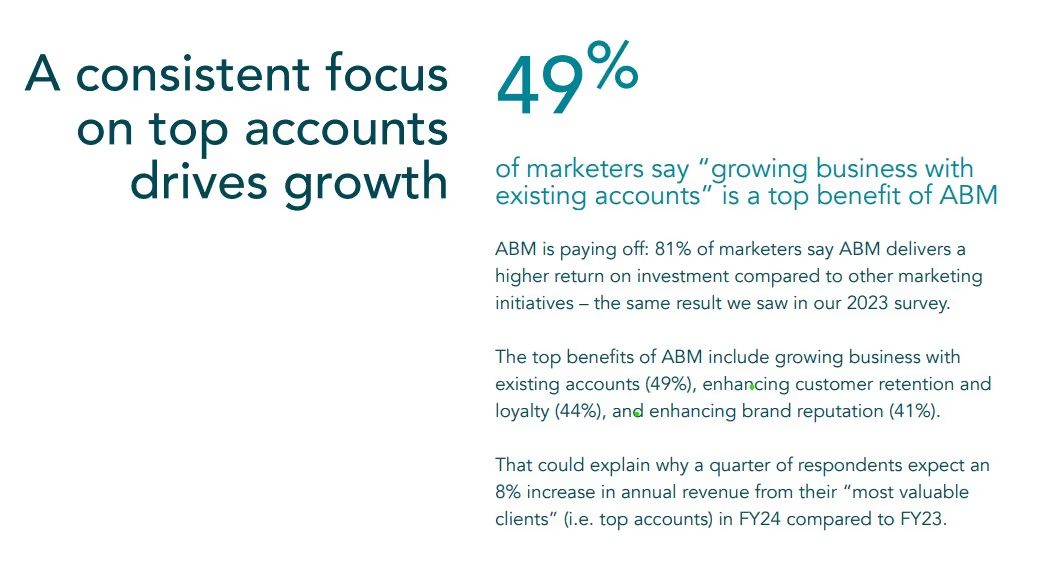
Speed Up Your Sales Cycle: When you know exactly who you’re targeting, you can deliver the right message at the right time. ABM helps you engage decision-makers with content that speaks to their specific challenges. The result? Faster deal cycles. Improved Sales and Marketing Alignment: ABM works best when sales and marketing are on the same page. Shared goals, unified messaging, and coordinated campaigns make moving accounts through the funnel easier.Increased Deal Size: ABM is all about focusing on the accounts that offer the biggest opportunities. By targeting the right people within buying committees and building trust through personalized outreach, you increase your chances of landing larger contracts. Stronger Customer Retention: ABM doesn’t stop once the deal is closed. ABM keeps working after the deal closes, helping you strengthen customer relationships, drive renewals, and increase lifetime value. 44% of marketers surveyed by Demandbase say it boosts retention and loyalty over time. If you’re looking to speed up your sales cycle and close bigger deals, now’s the time. Schedule a call with RevvGrowth and see how we can help you build a high-conversion ABM strategy.
3 Best Account Based Marketing Tools for 2026
There’s no shortage of account based marketing tools out there. But if you’re anything like me, you don’t have time to sift through endless options that all sound the same. You need a tool that’s simple to use, integrates with your existing systems, and helps you win more deals. Below are a few popular ABM tools that you can try.
1. 6sense
If you’re serious about using data to get ahead of your competition, 6sense is hard to beat. It helps you uncover accounts showing buying intent—even if they haven’t filled out a single form. What it does best:
- AI-powered predictive analytics to find in-market accounts
- Tracks anonymous web traffic and third-party intent signals
- Prioritises accounts most likely to buy
- Deep integration with Salesforce, HubSpot, and major CRMs
What Users Love: Accurate Intent Signals: Many users on G2 mention that 6sense is effective at surfacing accounts that are genuinely in buying mode. Great for Outbound Prospecting: Several users on Reddit mentioned that 6sense is really effective for outbound prospecting, particularly for BDRs (Business Development Reps).Common Complaints: Complex Onboarding: Multiple reviews on G2 mention a steep learning curve. Vague Data: Some Reddit users said 6sense data was too general and not actionable. Best For: Mid-market and enterprise SaaS companies with dedicated ABM teams looking to scale. Customer Ratings:
- G2: 4.4/5
- TrustRadius: 8.4/10
- Capterra: 4.6/5
2. Demandbase
Demandbase is an end-to-end solution that covers everything from account targeting to engagement and analytics. What It Does Best:
- Combines account intelligence, intent data, and engagement insights
- Supports multi-channel campaigns across ads, email, and social
- Real-time data updates and predictive scoring
- Easy integration with platforms like Slack, Salesforce, and Outreach
What Users Love: Brings Sales and Marketing Together: Users on G2 frequently mention that Demandbase makes it easier for sales and marketing teams to stay aligned with shared dashboards and insights. Robust Targeting Capabilities: On Reddit, a user shared their positive experience with Demandbase, particularly valuing its engagement data and journey stage tracking. Common Complaints: Steep Learning Curve: Some G2 reviews say the platform is challenging to navigate initially. Pricing Concerns: The cost structure may be a barrier for smaller teams. Best for: Enterprise SaaS teams with complex ABM needs and larger budgets.
Customer Ratings:
- G2: 4.3/5
- TrustRadius: 8.2/10
- Capterra: 4.4/5
3. Terminus
If you want to run ads, and emails, and personalize your website all in one place, Terminus makes it simple. It’s great for teams that want results without getting bogged down in technical setup. What It Does Best:
- Multi-channel ABM: ads, email signature marketing, website personalization
- Easy-to-use interface
- Strong Salesforce integration for seamless data flow
- Clear campaign analytics and reporting
What Users Love: Email Signature Marketing: Many users highlight email signature marketing as a differentiator. Simplicity: On G2, several reviews mention that Terminus is easy to set up and use. Customer Ratings:
- G2: 4.5/5
- TrustRadius: 8.3/10
- Capterra: 4.5/5
Also, For in-depth insight about various ABM tools, read 8 Best ABM Tools for 2025
Account-Based Marketing in 2026: Your Revenue Growth Starts Here
The way SaaS companies grow has changed. It’s no longer about filling the funnel with leads and hoping something sticks. The fastest-growing companies are the ones that focus—on the right accounts, the right conversations, and the right experiences. ABM isn’t a tactic. It’s not a one-off campaign. It’s a system for turning your best-fit accounts into long-term revenue. And the best part is that you don’t need a massive budget or team to start. You just need a strategy built on insight, alignment, and execution. The SaaS teams that embrace ABM today will be the ones winning the biggest deals tomorrow. If you’re ready to make ABM work for your SaaS business, start with a simple 10-account pilot today. Your best accounts are already out there—let’s go win them. Book your strategy call with RevvGrowth today and start closing high-value deals faster.
FAQs



.svg)
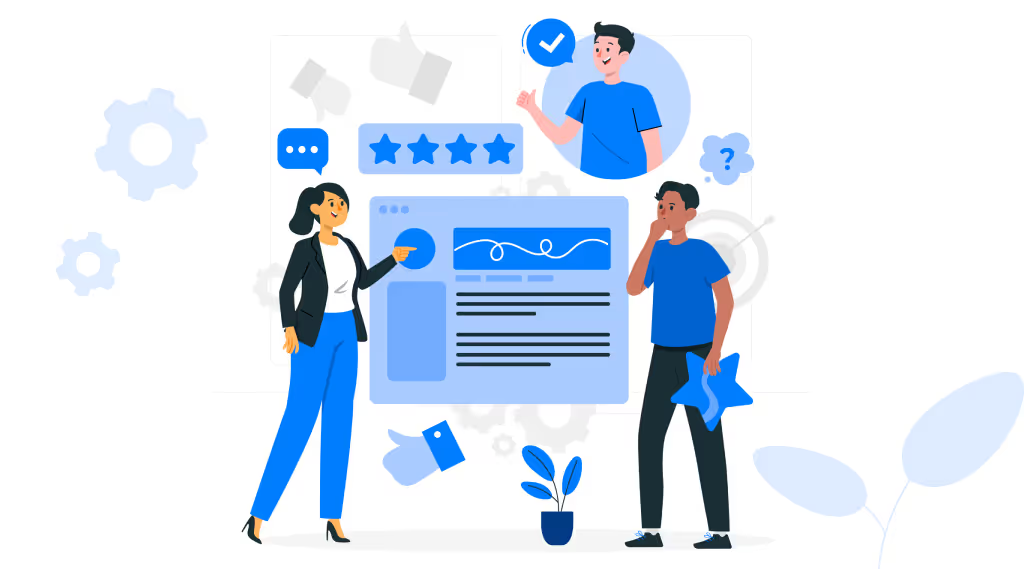

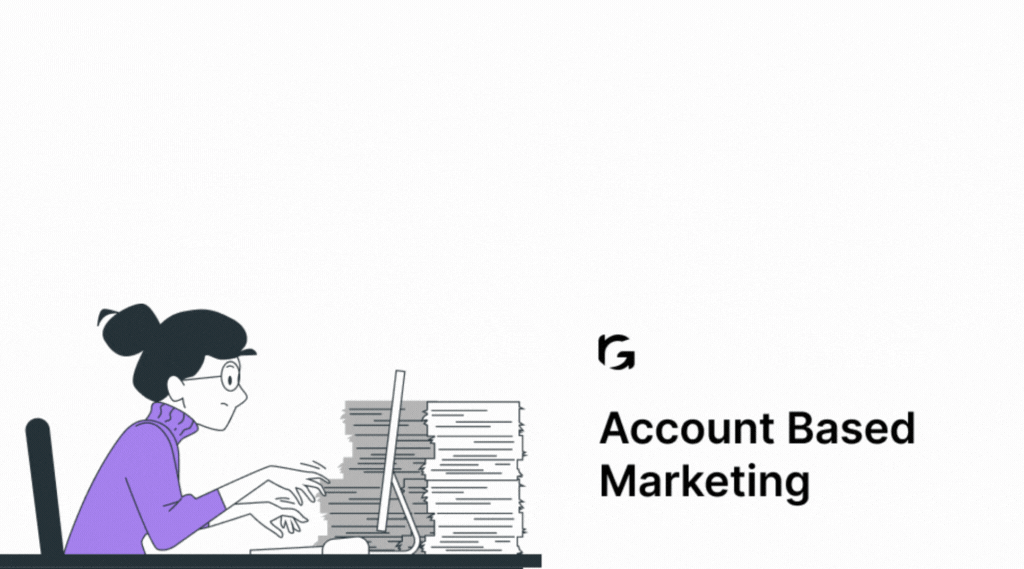
.webp)